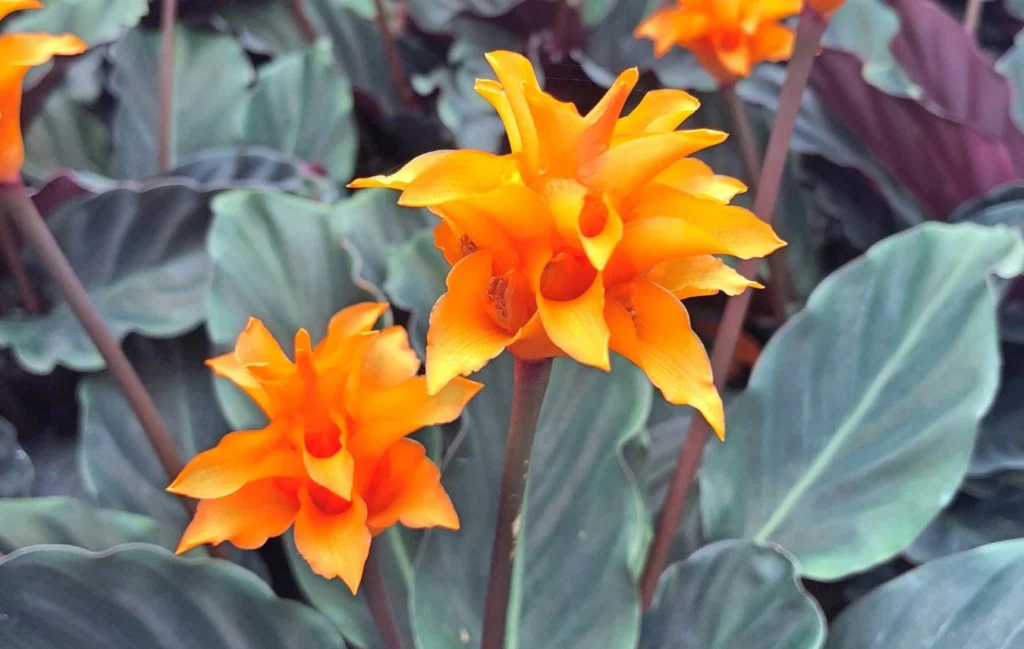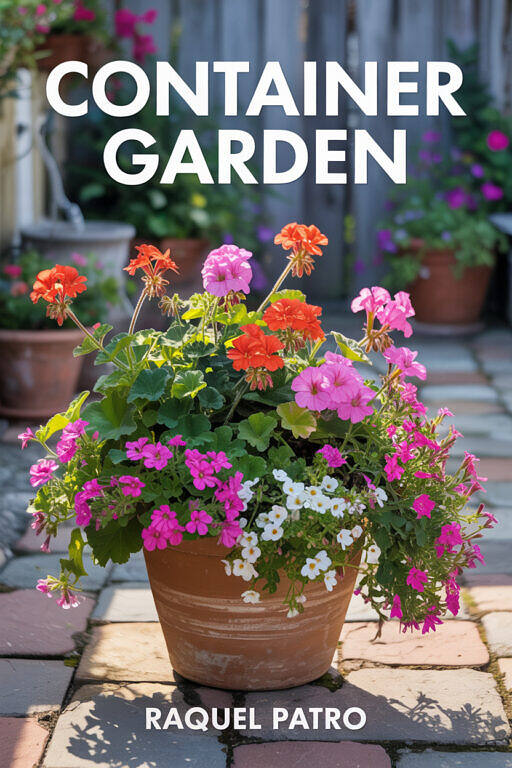The Eternal Flame Plant (Goeppertia crocata), also known as Saffron Colored Calathea, is a herbaceous, rhizomatous species from the Marantaceae family, native to Brazil’s tropical forests, specifically in the states of Bahia and Espírito Santo. Recognized worldwide for its vibrant saffron-orange inflorescences and lush foliage—it has even won the prestigious Royal Horticultural Society award—this plant is an excellent choice for interior decoration, adding a touch of color and life to indoor spaces.
The genus Goeppertia was named in honor of the German naturalist and paleobotanist Heinrich Göppert (1800–1884), who made significant contributions to the study of fossil plants. The specific epithet “crocata” derives from the Latin crocatus, meaning “saffron-colored” or “golden,” a direct reference to the intense orange-yellow hue of its floral bracts, reminiscent of the color of true saffron flowers (Crocus sativus).
Goeppertia crocata grows in clumps, reaching a height of 24 in (60 cm) and a width of 16 in (40 cm), making it an excellent option for pot cultivation. It has a rhizomatous root system with adventitious roots. The stem is reduced and underground, primarily represented by the rhizome. The leaves emerge directly from this rhizome, forming a basal rosette. They are arranged alternately and in a spiral, a common characteristic among Marantaceae.

The petioles are long and support highly ornamental, simple, entire, elliptic-shaped leaves with a leathery texture and slightly wavy margins. The upper surface of the leaves is dark green and slightly glossy, while the underside exhibits purplish to violet hues—an adaptive mechanism that reflects light back into the mesophyll, enhancing photosynthetic efficiency in shaded environments.
Another notable feature is the presence of a pubescent pulvinus at the base of the petiole. This pulvinus is a movement organ responsible for the plant’s nyctinasty, allowing the leaves to close at night and reopen at dawn. This characteristic movement of marantaceous plants has earned them the nickname “prayer plants.” Additionally, the petioles are enveloped by pubescent leaf sheaths and protected by cataphylls, structures that safeguard developing leaves.
The species blooms in spring and summer, provided it receives the right humidity and temperature conditions. The inflorescence of Goeppertia crocata is a compound spike supported by a long, erect peduncle that extends above the foliage. Each inflorescence consists of 15 to 27 bracts arranged in 5 to 7 horizontal series. These striking bracts are the plant’s main ornamental feature, displaying orange to saffron-yellow hues, inspiring its common names “Eternal Flame” and “Saffron Calathea.” The inflorescences can last up to three months, adding significant decorative value to the plant.
These bracts are glabrescent, with acute to long-acuminate tips, and their primary function is to protect the true flowers and attract pollinators. The actual flowers are smaller than the bracts and have a tubular structure. The corolla tube is narrow and discreetly hidden among the bracts. Fruiting in G. crocata is uncommon in ornamental cultivation, but when it occurs, the fruits are trilocular capsules containing small, arillate seeds.

With its combination of lush foliage and saffron-colored inflorescences, the eternal flame is widely used in indoor landscaping and tropical gardens. Its compact size and clumping growth habit make it an excellent choice for shaded gardens, forming mass plantings under tree groves, borders, and flowerbeds protected from direct sunlight. Indoors, it is cultivated as a focal plant in decorative pots, adding an exotic and sophisticated touch to living rooms, balconies, and offices. When grown in groups, it creates vibrant and elegant compositions, contrasting its orange bracts with the dark green foliage of other tropical species.
Some well-known cultivars include ‘Tassmania’, ‘Candela’, ‘Ventura’, ‘Afora’, and ‘Bicajoux’, which differ in leaf and inflorescence colors, as well as size and adaptability. With its long-lasting inflorescences, it is also used in floral arrangements and bouquets.
Goeppertia crocata is adapted to the understory of tropical forests, where it receives filtered light through the tree canopy. Therefore, it prefers bright, indirect light. Indoors, place it near east- or west-facing windows with sheer curtains to diffuse the light. Avoid direct sunlight, as it can cause leaf burns, leading to brown spots and fading. This species thrives in warm, stable environments, ideally between 64°F and 86°F (18°C to 30°C), and should be protected from sudden temperature fluctuations that may hinder its growth.
Humidity should always be kept above 50%, with ideal levels between 60% and 80%. To achieve this, use a humidifier, place the pot on a tray with pebbles and water, or mist the foliage two to three times a week with distilled water, always avoiding the flowers. It is also essential to keep the plant away from air currents, such as air conditioner vents and heaters, which dry out the air.
The substrate should mimic the rich, well-draining forest soil. A recommended mix includes 25% peat or coconut fiber for moisture retention, 25% organic compost or humus-rich potting soil for nutrients, 20% perlite or coarse sand to ensure good drainage and aeration, and 20% pine bark or charcoal to improve soil structure. The ideal soil pH ranges between 6.0 and 6.5, slightly acidic. To prevent excessive moisture buildup and root rot, it is advisable to add a drainage layer at the bottom of the pot using stones or expanded clay.
Watering should be done carefully to keep the soil consistently moist but not waterlogged. During spring and summer, watering may be needed once or twice a week, while in fall and winter, the frequency should be reduced to every 10 to 14 days, depending on soil moisture. The finger test is an effective method to determine when to water: simply insert your finger into the substrate, and if the top 0.8 inches (2 cm) are dry, it’s time to water.
Water quality is also crucial for the health of the eternal flame, as this plant is sensitive to chemicals found in tap water, such as chlorine and fluoride, which can cause brown spots on the leaves. Ideally, use rainwater, distilled, or filtered water. If only tap water is available, let it sit for 24 hours before use to allow the chlorine to evaporate.

Fertilization should be moderate and done monthly during the active growing season, from spring to summer, using a slow-release liquid or granular fertilizer, preferably with an NPK 10-10-10 formulation. In fall and winter, fertilization should be suspended, as the plant enters a slower growth phase. Excess fertilizer can be harmful, causing leaf burn along the edges and stunted growth. If this occurs, flush the soil thoroughly with water to remove accumulated residues.
Pruning Calathea crocata is simple and involves removing dry or damaged leaves at the base of the plant. Additionally, after the flowering period, it is important to cut off the dried flower stalks to encourage new growth. To prevent disease transmission, all pruning tools should be sterilized beforehand with alcohol or a disinfectant solution.
The eternal flame can be propagated using two main methods: rhizome division and seeds, with the first being the easiest. The first step in division is to remove the plant from the pot and gently loosen the soil around the roots. Next, natural divisions in the rhizome are identified and carefully separated, ensuring each new plant has healthy roots and at least one leaf. Each division should be planted in a new pot with suitable substrate and watered moderately. To encourage rooting, the cuttings should be kept in a humid, shaded environment, covered with transparent plastic to create a greenhouse effect. After two to three weeks, when new leaves emerge, the cover can be removed, and the plant can be cared for as usual.
Although possible, propagation by seeds is a more challenging and time-consuming method, as obtaining seeds is difficult. To germinate, they should be sown in trays with a sandy substrate, maintained at a temperature between 75°F and 86°F (24°C to 30°C) with high humidity. Covering the trays with plastic helps maintain optimal germination conditions. After three to four weeks, when the seedlings reach about 1.2 to 1.6 inches (3 to 4 cm) in height and develop two true leaves, they can be transplanted into individual pots.



